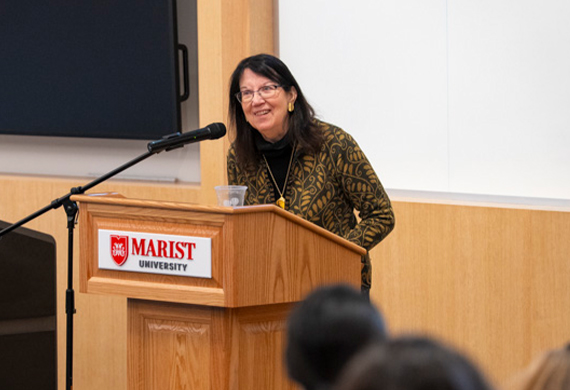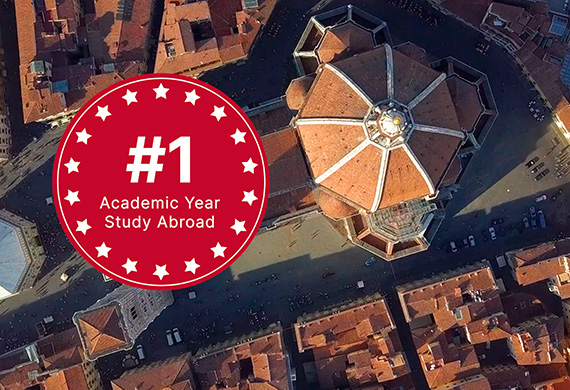Storytelling with Data
Anthony DeBarros ’86/’97MSIS, a data editor at The Wall Street Journal, is an expert in a field that combines journalism and computer science.
October 28, 2019—Thirty-three years ago, even before he graduated from Marist with a degree in English, Anthony DeBarros landed a job reporting news for the Poughkeepsie Journal. Soon after, he became enamored with computers, bought one, and went back to Marist for a master’s degree in information systems. Today DeBarros is an expert in a field that combines journalism and computer science. He is a data editor at The Wall Street Journal and author of the book Practical SQL: A Beginner’s Guide to Storytelling with Data.
A journalist for most of his career, he focuses on data analysis — “building, acquiring, vetting, and analyzing data sets to find news and trends,” he explained.
DeBarros began reporting news before he enrolled at Marist. After two years at Dutchess Community College in Poughkeepsie, he worked at radio station WEOK/WPDH in Poughkeepsie, first as a part-time DJ and then as a reporter.
Transferring to Marist, he majored in English with a concentration in writing. He continued reporting, for The Circle and for an internship at the Poughkeepsie Journal, a Gannett newspaper. He was inspired by his advisor at the time, journalism faculty member David McCraw, who today is vice president and deputy general counsel at The New York Times.
“He was instrumental in getting me into The Circle,” DeBarros said. “He became a major inspiration.”
A month before his graduation from Marist in 1986, the Poughkeepsie Journal hired DeBarros. He covered town government and the police department before leaving the newspaper briefly to travel. He returned in 1987 as a feature writer and went on to handle multiple roles, including editor of the Life section. He also taught journalism at
While at the Journal, he pursued the MSIS part- time at night.
“Data journalism has been a central theme of investigative reporting for well over 25 years, growing considerably in the last 10 years,” said DeBarros. “My involvement in data journalism began while I was at the Poughkeepsie Journal. I was studying for my MSIS at Marist at the time and was able to bring concepts about databases I learned in the classroom into the newsroom.”
“Today every major news publication has dedicated teams who focus on data analysis,” he said, citing The Wall Street Journal, The New York Times, and The Washington Post.
When Gannett’s flagship newspaper, USA Today, offered him a position as database editor in 1997, he and his family moved from Hyde Park, NY, to the Washington, DC, area. He became one of four database editors at the national newspaper, working on the Life section on stories related to health, education, demographics, and entertainment. In 2008, USA Today promoted him to the new position of senior database editor. He took on management of the team of database editors — “by then we called ourselves data journalists” — and expanded the team to six people. During that time, he became more involved with investigative stories and interactive data visualizations, and the team won multiple awards.
In 2012, he was offered a spot with Gannett Digital, a division of the parent company that built its Web sites and mobile apps. He created a small team that made apps for election results, investigations, and other stories. He also produced a first-of-its-kind virtual reality project called Harvest of Change for Gannett’s Des Moines Register.
A longtime member of the nonprofit organization Investigative Reporters and Editors (IRE), he has been a frequent speaker and trainer at its conferences. Through a grant from the Knight Foundation, he joined the IRE staff full-time in 2015 as director of product development for DocumentCloud, a Web-based software platform for organizing, researching, annotating, and publishing primary source documents.
After DocumentCloud, he worked for a small publishing and events company, leading product development and content strategy. In September 2018, he joined the staff of The Wall Street Journal as data news editor in its Washington, DC, bureau.
Early on, a Wall Street Journal project he worked on won an award. He was part of a team that reported the data behind the visual “China: Emergence of a Trade Leviathan,” which explained China’s rise to power as a U.S. trading partner (www.wsj.com/graphics/china-emergence-of-a-trade-leviathan/). The Society for News Design awarded the piece a bronze medal in its Best of Digital Design competition, in which 13 judges from around the globe reviewed 1,300 entries.
Practical SQL was released by the San Francisco tech publisher No Starch Press in May 2018. Its genesis was his blog about technology and journalism. The posts that drew the most readers were his short explainers on how to install or use software.
“I had learned the database language SQL while studying for my master’s at Marist, and over the years it became a big part of my data analysis toolkit. Many have written books about SQL, but I thought it would be helpful to write one that used real-world data rather than the hypothetical examples you typically find in a textbook.”
He began the book in 2011, writing on the bus, on the train, and on planes, whenever he could find time. After producing nine chapters, he found a publisher who offered him a contract.
“As a one-time staff member of Marist’s student newspaper, The Circle, and a beneficiary of both the school’s outstanding journalism and computer science programs, my book reflects how the preparation I received at Marist helped me excel in my career,” he said.
As for the future, his expertise in data journalism gives him an informed perspective on what’s next in the field. “I’m excited about finding uses for machine learning and artificial intelligence as well as employing automation to gather and analyze data.”
Photo courtesy of Stephen Voss



